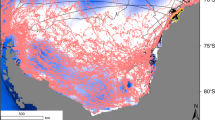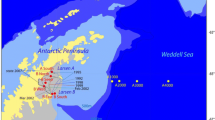Abstract
The aim of this study was to contribute to a general understanding of the response of the Antarctic macrobenthos to environmental variability and climate-induced changes. The change in population size of selected macrobenthic organisms was investigated in the Larsen A area east of the Antarctic Peninsula in 2007 and 2011 using ROV-based imaging methods. The results were complemented by data from the Larsen B collected in 2007 to allow a conceptual reconstruction of the environment-driven changes before the period of investigation. Both Larsen areas are characterised by ice-shelf disintegration in 1995 and 2002, respectively, as well as high inter-annual variability in sea-ice cover and oceanographic conditions. In 2007 one ascidian species, Molgula pedunculata, was abundant north and south of the stripe of remaining ice shelf between Larsen A and B. Population densities decreased drastically in the Larsen A between 2007 and 2011, coincident with the decrease in Corella eumyota, another ascidian. Among the ophiuroids, the population of deposit feeders increased, while suspension feeders halved their abundance. Current measurements indicated a northward flow between the Larsen B and Larsen A, suggesting that a major physical forcing on benthic population development comes from the South. The results demonstrate that Antarctic macrobenthic populations can exhibit dramatic population dynamics. Analyses of sea-ice dynamics, salinity, temperature and surprisingly ice-shelf disintegration history, however, did not provide any clear evidence for environmental drivers underlying the apparent changes.






Similar content being viewed by others
References
Arnaud PM, López CM, Olaso I, Ramil F, Ramos-Esplá RA (1998) Semi-quantitative study of macrobenthic fauna in the region of the South Shetland Islands and the Antarctic Peninsula. Polar Biol 19:160–166
Arrigo KR, van Dijken GL, Ainley DG, Fahnstock MA, Markus T (2002) Ecological impact of a large Antarctic iceberg. Geophys Res Lett 29(7). doi:10.1029/2001GL014160
Barnes DKA, Conlan K (2007) Disturbance, colonization and development of Antarctic benthic communities. Phil Trans R Soc B 362:11–38
Barnes DKA, Souster T (2011) Reduced survival of Antarctic benthos linked to climate-induced iceberg scouring. Nat Clim Chang 1:365–368
Bertolin ML, Schloss IR (2009) Phytoplankton production after the collapse of the Larsen A Ice Shelf, Antarctica. Polar Biol 32:1435–1446
Dahm C (1999) Ophiuroids (Echinodermata) of southern Chile and the Antarctic: taxonomy, biomass, diet and growth of dominant species. Sci Mar 63:427–432
Dayton PK (1979) Observations of growth, dispersal and population dynamics of some sponges in McMurdo Sound, Antarctica. Colloques internationaux du C.N.R.S. Biologie des Spongiaires 291:271–282
Dayton PK (1989) Interdecadal recruitment and destruction of an Antarctic sponge population and its effect on local populations of Asteroids. Science 245:1484–1486
Dayton PK (1990) Polar Benthos. In: Smith WO (ed) Polar oceanography, part B: chemistry, biology, and geology. Academic Press, London, pp 631–685
Dayton PK, Kim S, Jarrell SC, Oliver JS, Hammerstrom K, Fisher JL, O’Connor K, Barber JS, Robillard G, Barry J, Thurber AR, Conlan K (2013) Recruitment, growth and mortality of an Antarctic hexactinellid sponge, Anoxycalyx joubini. PLoS ONE 8(2):e56939. doi:10.1371/journal.pone.0056939
Fell HB, Holzinger T, Sherraden M (1969) Ophiuroides. In: Bushnell VC, Hedgpeth JW (eds) Antarctic map folio series. American Geographical Society Folio, vol 11, pp 42–43
Fillinger L, Funke T (2012) A new 3-D-modelling method to extract subtransect dimensions from underwater videos. Ocean Sci Discuss 9:1–39. doi:10.5194/osd-9-3879
Gallardo VA (1987) The sublittoral macrofaunal benthos of the Antarctic Shelf. Environ Int 13:71–81
Gutt J (2001) On the direct impact of ice on marine benthic communities, a review. Polar Biol 24:553–564
Gutt J (2008) The Expedition ANTARKTIS-XXIII/8 of the Research Vessel “Polarstern” in 2006/2007. Ber Polarforsch Meeresforsch 569:1–152
Gutt J, Piepenburg D (2003) Scale-dependent impact on diversity of Antarctic benthos caused by grounding of icebergs. Mar Ecol Progr Ser 253:77–83
Gutt J, Schickan T (1998) Epibiotic relationships on the Antarctic benthos. Antarct Sci 10:398–405
Gutt J, Starmans A (2001) Quantification of iceberg impact and benthic recolonisation patterns in the Weddell Sea (Antarctica). Polar Biol 24:615–619
Gutt J, Starmans A (2003) Patchiness of the megabenthos at small scales: ecological conclusions by examples from polar shelves. Polar Biol 26:276–278
Gutt J, Barratt I, Domack E, d’Udekem d’Acoz C, Dimmler W, Grémare A, Heilmayer O, Isla E, Janussen D, Jorgensen E, Kock K-H, Lehnert LS, López-Gonzáles P, Langner S, Linse K, Manjón-Cabeza ME, Meißner M, Montiel A, Raes M, Robert H, Rose A, Sañé Schepisi E, Saucède T, Scheidat M, Schenke H-W, Seiler J, Smith C (2011) Biodiversity change after climate-induced ice-shelf collapse in the Antarctic. Deep-Sea Res II 58:74–83
Haran T, Bohlander J, Scambos T, Painter T, Fahnestock M (compilers) (2005, updated 2006) MODIS mosaic of Antarctica (MOA) image map. Boulder, Colorado USA: National Snow and Ice Data Center. Digital media. http://nsidc.org/data/moa/. Accessed 1 January 2013
Knust R, Gerdes D, Mintenbeck K (2012) The Expedition of the Research Vessel “Polarstern” to the Antarctic in 2011 (ANT-XXVII/3) (CAMBIO). Ber Polarforsch Meeresforsch 644:1–200
Koplowitz G, McClintock JB, Amsler C, Baker BJ (2009) Palatability and chemical anti-predatory defences in common ascidians from Antarctic Peninsula. Aquatic Biol 7:81–92
Kott P (1969) Ascidiacea. In: Bushnell VC, Hedgpeth JW (eds) Antarctic map folio series. American Geographical Society Folio, vol 11, pp 43–44
Lambert G, Lambert CC (1987) Spicule formation in the solitary ascidian, Herdmania momus. J Morphol 192:145–159
López-Legentil S, Turon X, Schupp P (2006) Chemical and physical defenses against predators in Cystodytes (Ascidiacea). J Exp Mar Biol Ecol 332:27–36
Manjon-Cabeza ME, Ramos A (2003) Ophiuroid community structure of the South Shetland Islands and Antarctic Peninsula region. Polar Biol 26:691–699
Marshall GJ, Orr A, van Lipzig NPM, King JC (2006) The impact of a changing Southern Hemisphere Annular Mode on Antarctic Peninsula summer temperatures. J Clim 19(20):5388–5404
McClintock JB, Baker BJ, Hamann MT, Yoshida W, Slattery M, Heine JN, Bryan PJ, Jayatilake GS, Moon BH (1994) Homarine as a feeding deterrent in common shallow-water antarctic lamellarian gastropod Marseniopsis mollis: a rare example of chemical defense in a marine prosobranch. J Chem Ecol 20(10):2539–2549
Monniot C, Monniot F (1983) Ascidies Antarctiques et Subantarctiques: morphologie et Biogeographie. Mem Mus Natl Hist Nat Ser A Zool 125:1–135
Piepenburg D, Schmid MK, Gerdes D (2002) The benthos off King George Island (South Shetland Islands, Antarctica): further evidence for a lack of a latitude biomass cline in the Southern Ocean. Polar Biol 25:146–158
Sahade R, Tatián M, Kowalke J, Kühne S, Esnal GB (1998) Benthic faunal associations on soft substrates at Potter Cove, King George Island, Antarctica. Polar Biol 19:85–91
Sanamyan K (2012) Molgula pedunculata Herdman, 1881. In: Shenkar N, Gittenberger A, Lambert G, Rius M, Moreira Da Rocha R, Swalla BJ, Turron X (eds) Ascidiacea World Database. http://www.marinespecies.org/ascidiacea./aphia.php?p=taxdetails&id=173279. Accessed 31 December 2012
Sañé E, Isla E, Grémare A, Gutt J, Vétion G, DeMaster DJ (2011) Pigments in sediments beneath recently collapsed ice shelves: the case of Larsen A and B shelves, Antarctic Peninsula. J Sea Res 65:94–102
Scambos T, Bohlander J, Raup B (1996) Images of Antarctic ice shelves. Boulder, Colorado, USA: National Snow and Ice Data Center. Digital media. http://nsidc.org/data/iceshelves_images/. Accessed 31 December 2012
Skvarca P, De Angelis H (2003) Impact assessment of regional climatic warming on glaciers and ice shelves of the northeastern Antarctic Peninsula. Antarct Res Ser 79:69–78
Smith CR, Grange LJ, Honig DL, Naudts L, Huber B, Guidi L, Domack E (2012) A large population of king crabs in Palmer Deep on the west Antarctic Peninsula shelf and potential invasive impacts. Proc R Soc B 279:1017–1026
Spreen G, Kaleschke L, Heygster G (2008) Sea ice remote sensing using AMSR-E 89-GHz channels. J Geophys Res 113:C02S03. doi:10.1029/2005JC003384
Sumida PYG, Bernadino AF, Stedall VP, Glover AG, Smith CR (2008) Temporal changes in benthic megafaunal abundance and composition across the West Antarctic Peninsula shelf: results from video surveys. Deep-Sea Res II 55:2465–2477
Torre L, Servetto N, Eöry ML, Momo F, Tatián M, Abele D, Sahade R (2012) Respiratory responses of three Antarctic ascidians and a sea pen to increase sediment concentrations. Polar Biol 35:1743–1748
Turner J, Marshall GJ (2011) Climate change in the Polar Regions. Cambridge University Press, Cambridge
Turner J, Bindschadler R, Convey P, di Prisco G, Fahrbach E, Gutt J, Hodgson D, Mayewsky P, Summerhayes C (2009) Antarctic climate change and the environment. SCAR, Scott Polar Research Institute, Cambridge
Acknowledgments
Thanks are due to those who made a repetitive study in such an area of very difficult accessibility possible, referees, science managers, the crew of “Polarstern” and to the experts that helped with the identification of taxa (s.l.), A. Boetius, M. Taitán, R. Sahade and C. Sands. M. Cape was funded by the US National Science Foundation (NSF) grant ANT-0732983, the US National Aeronautics and Space Administration (NASA) award 12-EARTH12F-0091 and a US NSF Graduate Research Fellowship.
Author information
Authors and Affiliations
Corresponding author
Rights and permissions
About this article
Cite this article
Gutt, J., Cape, M., Dimmler, W. et al. Shifts in Antarctic megabenthic structure after ice-shelf disintegration in the Larsen area east of the Antarctic Peninsula. Polar Biol 36, 895–906 (2013). https://doi.org/10.1007/s00300-013-1315-7
Received:
Revised:
Accepted:
Published:
Issue Date:
DOI: https://doi.org/10.1007/s00300-013-1315-7




